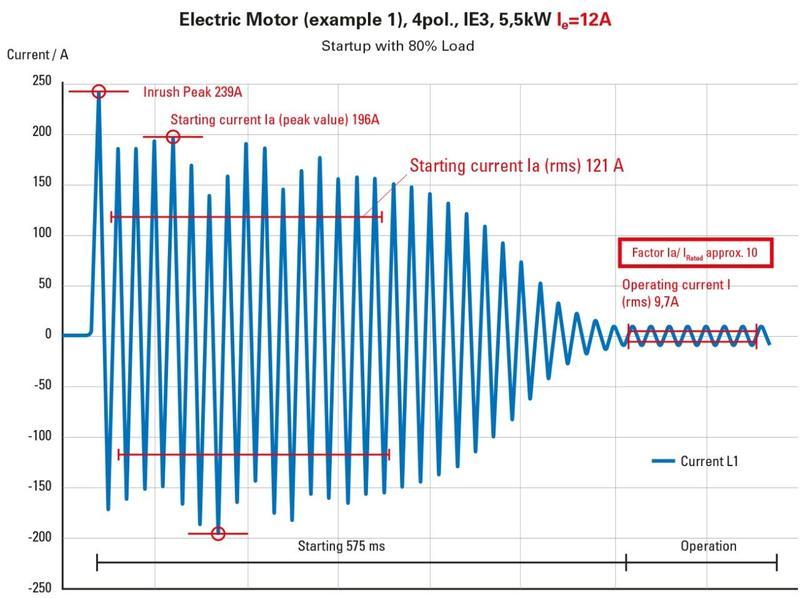Implementing Energy-efficient Drive Systems

When using IE3 and IE4 motors, looking at the system as a whole is always necessary. This is partly because the full optimisation potential of a drive system can only be realised by coordinating the motor and motor controller components (motor starter, variable speed drive). However, it is also because IE3 and IE4 motors have special properties that directly affect the other components in the drive system – particularly the switchgear.
STARTING CURRENTS
To meet the energy efficiency requirements specified in IEC 60034-30-1, IE3 and IE4 motors typically have higher inductance and lower copper losses, resulting in higher starting currents than standard IE1 and IE2 motors.
If we take a closer look at the starting period of IE3 and IE4 motors, we can distinguish between two types of current: The inrush current only occurs in the first and second half-cycle after the motor is switched on. Compared to an IE1 motor, this peak inrush current – depending on the rated power – is between 20% and 50% higher in the case of IE3 motors, and even higher for IE4 motors.
The subsequent starting current is also significantly higher for IE3 motors – the starting current ratio (starting current/ nominal current) increases by up to 35% for motors with an output of less than <3kW, by up to 15% for medium-sized motors and by less than 7% for motors with more than 75kW. Here again, IE4 motors have a significantly higher starting-current ratio. The lower nominal current is only reached after the inrush and starting current has decayed.
Switchgear that is used together with IE3 and IE4 motors must be able to safely handle both the higher starting and inrush currents. This also means that the motor protection system needs to be able to distinguish between the motor inrush current and a fault (for exmple a short circuit). The relationship between the inrush current and the effective value of the full load current of the motor plays an important role because it is related to the response value the short-circuit release of the motor-protective circuit breakers. Only if the short-circuit tripping current is above the ratio between the peak value of the inrush current and the effective value of the full load current of the IE3 or IE4 motor no unwanted tripping occurs when the motor is switched on.
Contemporary programs for dimensioning lowvoltage networks help with the correct selection of protective components. The xSpider program from Eaton, for example, also takes the influence of the motors into account when calculating the short-circuit current.
MOTOR STARTERS
Care should be taken to ensure that motor starters and soft starters are approved for operation with energy-efficient motors. This is because if the contactors are not suitable for IE3 or IE4 motors, the increased starting currents cause faster wear of the contact device and, thus, faster welding of the contacts. For applications involving frequent switching operations this can lead to the process coming to a standstill.
The same applies to motorprotective circuit breakers or motor starter combinations. These must also be designed for operation with increased starting currents so that they do not lead to false tripping and faster wear. As a result, there is no need to fear an increased maintenance effort. Eaton's motor starters meet the latest requirements of the IEC/EN 60947-x series of standards.
INCREASING ENERGY EFFICIENCY
To achieve the highest energy savings in an application the mechanical parts of the system should definitely be considered in addition to the motor, control gear and switchgear. According to the ZVEI (German Electrical and Electronic Manufacturers' Association), approximately 10% of the potential savings that can be achieved in the drive system can be achieved by using efficient motors. Speed-controlled operation results in a savings potential of around 30%. However, the greatest potential of about 60% lies in the optimisation of the entire system.
Only with an energy management system in accordance with ISO 50001 can companies implement systems and processes that allow energy consumption to be continuously improved. An essential element of such an energy management system is the detailed recording of energy consumption throughout the company. Instead of retrofitting or equipping a system with separate measuring devices at considerable cost, energy measurement can also be realised with modern digital circuit breakers such as the NZM from Eaton. Thanks to their communication interface, they provide important information in the framework of energy management systems.

